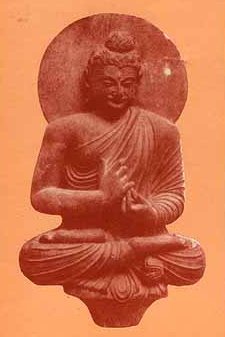Titthati, Tiṭṭhati: 2 definitions
Introduction:
Titthati means something in Buddhism, Pali. If you want to know the exact meaning, history, etymology or English translation of this term then check out the descriptions on this page. Add your comment or reference to a book if you want to contribute to this summary article.
Languages of India and abroad
Pali-English dictionary
Source: BuddhaSasana: Concise Pali-English Dictionarytiṭṭhati : (ṭhā + a; ṭhā is changed to tiṭṭha) stands; stays; abides; lasts; remains. (comparative tiṭṭhatu has the meaning; leave it alone or let it be so).
Source: Sutta: The Pali Text Society's Pali-English DictionaryTiṭṭhati, (Frequentative of Vedic sthā, stand (cp. sthāna, Lat. sto: see ṭhāna)=Av. hiśtaiti, Gr. i(ζthmi, Lat. sisto) to stand, etc.—I. Forms: pres. ind. tiṭṭhati (Sn. 333, 434; Pv. I, 51); imper. 2nd tiṭṭha, 3rd tiṭṭhatu; ppr. tiṭṭhaṃ, tiṭṭhanto, tiṭṭhamāna; pot. tiṭṭhe (Sn. 918, 968) & tiṭṭheyya (Sn. 942); fut. ṭhassati (J. I, 172, 217); aor. aṭṭhāsi (J. I, 279, pl. aṭṭhaṃsu J. II, 129) & aṭṭhā (cp. agā, orig. impf.) (Sn. 429; J. I, 188); inf. ṭhātuṃ (PvA. 174); ger. ṭhatvā (Sn. 887); grd. ṭhānīya (PvA. 72).—pp. ṭhita, Caus. ṭhapeti. An apparent Med. -Pass. ṭhīyati, as found in cpd. pati-ṭṭhīyati is to be explained as Med. of paṭi+sthyā (see thīna), and should be written paṭi-tthīyati. See under patiṭṭhīyati. See also ṭhāna & ṭhiti.—II. Meanings.—1. to stand, stand up, to be standing (see ṭhāna I. 1a): ṭhānakappana-vacanaṃ nisajjādi-paṭikkhepato PvA. 24; opp. to walking or lying down: tiṭṭhaṃ caraṃ nisinno vā Sn. 151, 193; tiṭṭhamānāya eva c’assā gabbhavuṭṭhānaṃ ahosi “she was delivered standing” J. I, 52; ekamantaṃ aṭṭhāsi PvA. 68, etc.; caṅkamana-koṭiyaṃ ṭhatvā PvA. 79.—2. to stop, stay, abide; to last, endure, be at rest; fig. to remain in, abide by, acquiesce in (see ṭhāna I. 1b). In imper. tiṭṭhatu it approaches the meanings of ṭhapeti viz. leave it alone, let it be so, all right. yāva kāyo ṭhassati tāva naṃ dakkhinti deva-manussā (as long as the body shall last) D. I, 46. tiṭṭhe shall he live on (cp. ṭhāna II. d Sn. 1053, 1072 =Nd2 283, tiṭṭheyya saṭṭhikappasahassāni to stay on indefinitely); tiṭṭheyya kappaṃ D. II, 103. tiṭṭhantī anto vimānasmiṃ “remaining inside the castle” Pv. I, 101; tiṭṭha tāva “stop please” J. II, 352; tiṭṭhabhadantika one who bids the guest stay (combined w. ehi-bh°) D. I, 166; M. I, 342; A. I, 295; II, 206: ovāde ṭhatvā (abiding by) J. I, 153; VI, 367; similarly J. VI, 336.—Imper. tiṭṭhatu J. IV, 40; Miln. 14; PvA. 74.—3. to live (on=Instr.), behave, exist, be (see ṭhāna I. 2); to be in a certain condition (gati, cp. ṭhāna II. (c)). Often periphrastically for finite verb (with ger. : cp. gata & ṭhita) tiṭṭhantam enaṃ jānāti (he knows their “gati”) Sn. 1114 (see Nd2 283); āhārena tiṭṭhati PvA. 27 (is supported by, cp. ṭhiti); yāvatāyukaṃ ṭhatvā (outliving their lives) PvA. 66; karuṇa-ṭhānīya (=*kāruṇayitabba) deserving pity PvA. 72; yā tvaṃ tiṭṭhasi (how you are or look!) Vv 441, etc.—with ger. : pharitvā aṭṭhāsi (pervaded) J. VI, 367; aṭṭhiṃ āhacca aṭṭhāsi (cut through to the bone) J. IV, 415; gehaṃ samparivāretvā aṭṭhaṃsu (encircled the house) PvA. 22. (Page 301)

Pali is the language of the Tipiṭaka, which is the sacred canon of Theravāda Buddhism and contains much of the Buddha’s speech. Closeley related to Sanskrit, both languages are used interchangeably between religions.
See also (Relevant definitions)
Ends with: Abhititthati, Anutitthati, Avatitthati, Patititthati, Patitthati, Santitthati, Upatitthati, Uttitthati.
Full-text (+20): Thita, Atthasi, Thatum, Titthanta, Titthamana, Patititthati, Thaniya, Thatva, Anutitthati, Abhititthati, Ajjhosa, Saloka, Apatthapeti, Anutthahati, Nitthati, Adiccupatthana, Avatitthati, Ajjhosaya, Upatitthati, Thayin.
Relevant text
Search found 9 books and stories containing Titthati, Tiṭṭhati; (plurals include: Titthatis, Tiṭṭhatis). You can also click to the full overview containing English textual excerpts. Below are direct links for the most relevant articles:
Gemstones of the Good Dhamma (by Ven. S. Dhammika)
Maha Prajnaparamita Sastra (by Gelongma Karma Migme Chödrön)
The formless absorptions (ārūpyasamāpatti) according to the Mahāyāna < [Class 4: The four formless absorptions]
Bodhisattva quality 8: having renounced greed and ambition < [Chapter X - The Qualities of the Bodhisattvas]
I. Tathatā, Dharmadhātu and Bhūtakoṭi < [Part 2 - Understanding dharmatā and its synonyms]
Dhammapada (Illustrated) (by Ven. Weagoda Sarada Maha Thero)
Verse 338-343 - The Young Sow < [Chapter 24 - Taṇhā Vagga (Craving)]
The Great Chronicle of Buddhas (by Ven. Mingun Sayadaw)
Part 1 - The Week on the Throne (Pallanka Sattāha) < [Chapter 8 - The Buddha’s stay at the Seven Places]
Part 5 - Taming of Baka Brahmā < [Chapter 35 - Story of Māra]
The Mahavastu (great story) (by J. J. Jones)
Chapter II-a - Sermon on the Hells (naraka) < [Volume I]
Chapter XXXI - The final defeat of Māra < [Volume II]
Chapter II - The Group On Cause < [Part I]